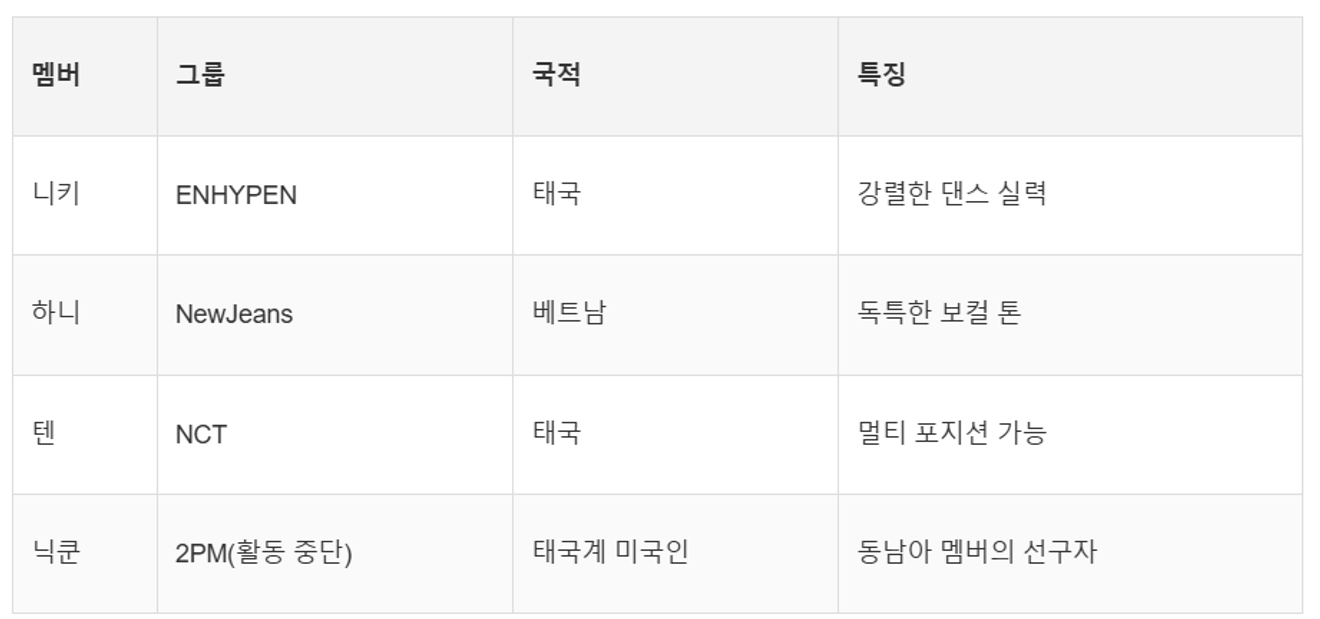Subject
- #Localization
- #K-Pop
- #Southeast Asian Members
- #4th Generation Idols
- #Global Strategy
Created: 2025-03-28
Created: 2025-03-28 10:00

Baby Monster Chikita, Hearts to Hearts Carmen
Recently, there's been a noticeable increase in the number of Southeast Asian members in 4th generation K-pop idol groups.
Looking at the K-pop scene in 2025, members from Thailand, Vietnam, and Indonesia are actively participating in various groups.
This isn't mere coincidence; it's closely related to the inner workings of the K-pop industry.
Why are Southeast Asian members receiving so much attention?
In this article, we delve into the global strategy of 4th generation idols and uncover the hidden stories behind their success.
4th generation idols officially emerged in the early 2020s.
Girl groups like aespa, IVE, and NewJeans, and boy groups like ENHYPEN and Stray Kids are prime examples.
A common characteristic of these groups is the high proportion of foreign members.
In particular, Niki (ENHYPEN) from Thailand, Ten (NCT) of Thai descent, and Hanni (NewJeans) from Vietnam are gaining significant attention.
On X (formerly Twitter), fan posts stating that "Southeast Asian members add a new charm to K-pop" are trending.
According to Namuwiki (a Korean wiki), the diversification of K-pop groups has accelerated to the point where groups composed entirely of Koreans are rare in the 4th generation.
Looking into the inner workings of K-pop, the increase in Southeast Asian members is a strategic choice.
Firstly, Southeast Asia has emerged as a major market for K-pop.
Thailand, Vietnam, and Indonesia are experiencing rapid growth in fan base size and concert revenue.
Secondly, it's an attempt to strengthen cultural understanding with Southeast Asian fans through localization strategies.
For example, Hanni is receiving positive feedback from Vietnamese fans who feel a sense of closeness to her.
Thirdly, the skills of trainees from Southeast Asia have noticeably improved since the 3rd generation.
Let's take a look at which Southeast Asian K-pop members are currently active.
The table below summarizes the key members:

Key Members
4th generation idols target the global market from their debut.
Southeast Asian members are a key factor in achieving this goal.
Thai fans feel a sense of pride, viewing Niki as their "national idol."
In Vietnam, Hanni significantly boosted NewJeans's popularity.
Agencies utilize Southeast Asian members to enhance content using local languages and culture.
This is considered a successful case of the 4th generation idol's international strategy.
However, there are also challenges within the K-pop industry.
Southeast Asian members often face difficulties adapting to the Korean language and culture.
On X, one fan expressed their hope that "Niki's Korean skills would improve further."
Some fans also express concerns about the "high proportion of foreign members."
There are opinions that synergy with Korean members is important.
Nevertheless, the charm of Southeast Asian members is a driving force behind the diversification of K-pop.
Beyond 2025, and into the 5th generation of idols, the number of Southeast Asian members is likely to continue increasing.
Major agencies such as SM, JYP, and HYBE are expanding their auditions in Southeast Asia.
Southeast Asian K-pop members will serve as a bridge to the global fandom.
On X trends, posts stating that "Southeast Asian members are the future of K-pop" are gaining attention.
K-pop is now establishing itself as truly global music, transcending national borders.
Q1. Which group has the most Southeast Asian members?
A1. NCT is known for its multinational members, including members from Thailand (Ten) and Taiwan (Yangyang).
Q2. Why are Southeast Asian members so popular?
A2. It's due to their unique appearances and the influx of local fans.
Q3. Is the number of Korean members decreasing?
A3. While not decreasing, multinational group compositions have become a trend.
Comments0